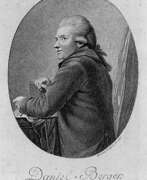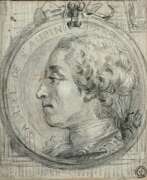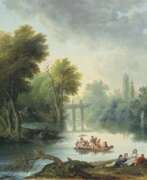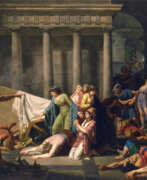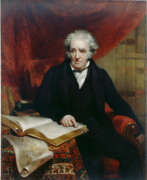Illustrators 18th century


Eleazar Albin was a British naturalist and author of illustrated books on birds and insects.
Albin wrote and illustrated a number of books, including A Natural History of English Insects (1720), A Natural History of Birds (1731-38), and A Natural History of Spiders and Other Curious Insects (1736). His work was based on careful observation and artistic talent. Eleazar Albin has been called one of the "great illustrators of entomological books of the 18th century".
Some of the illustrations in these books are by Albin's daughter Elisabeth. Eleazar Albin himself proudly wrote of his drawings that they were all painted from life, with all the accuracy of a sketch, unlike the sketches of other scientists, who did them either from memory or from stories.


William Alexander was a British painter, illustrator and printmaker.
He studied painting at the Royal Academy and became a very famous artist. In 1792-1794 he accompanied the official embassy to Peking of Lord George Macartney on behalf of the British government, where he documented the visit and made many drawings of the Chinese court. These depict various mandarins, merchants, members of the royal family and members of Chinese society. In 1805, William Alexander published Costume of China, an album illustrated with 48 color prints, which was a success with the public.


Samuel Alken the Elder was a British painter, printmaker and illustrator.
Samuel Alken studied at the Royal Academy School in London. In 1779 he published A New Book of Ornaments Designed and Engraved by Samuel Alken, and later established himself as one of the most distinguished engravers in the new technique of aquatint. Alken produced magnificent compositions of the British countryside, including moonlit night scenes. His works include engravings by George Morland, Richard Wilson, Thomas Rowlandson, and Francis Wheatley. In 1796 his plates of sixteen views of the lakes of Cumberland and Westmorland, after drawings by John Ames and John Smith, were published, and in 1798 a set of aquatint views of North Wales after drawings by the Rev. Brian Broughton.
His sons, Samuel Alken the Younger (1784-1824), Henry Thomas Alken (1785-1851) and Samuel Henry Alken (1810-1894) also became artists.
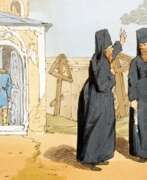

John Augustus Atkinson was a British watercolorist, illustrator and engraver.
In 1784, the young Atkinson traveled to St. Petersburg, Russia, to stay with his uncle James Walker, who worked as an engraver at the court of Empress Catherine the Great. The aspiring artist learned from the work of the great Russian painters whose paintings he saw in the art galleries of St. Petersburg. Catherine and her son Paul I, noticing his talent, commissioned Atkinson to paint pictures on historical subjects.
In 1801 Atkinson returned to England and a year later published an album entitled "Pictorial representation of Russian manners, customs and amusements" on 100 plates drawn and engraved by himself. This work was a great success in Europe. Later, during the Napoleonic Wars, Atkinson created many battle scenes, including the Battle of Waterloo and naval battles. In 1808 he was elected to the Society of Watercolor Painters.


James Barenger is a British animal artist and illustrator.
He was born James Barenger Sr. James Barenger was a metal chaser and naturalist painter. Barenger specialized in depicting horses, dogs, and other animals, as well as noblemen's hunting scenes, which were consistently successful in the 19th century.
Barenger's patrons included the Duke of Grafton, the Marquis of Londonderry and the Earl of Derby. The artist produced entire series of prints depicting hunting, shooting, bullfighting and horse racing, which were published in sporting publications.
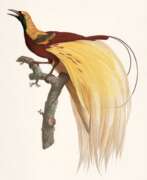

Jacques Barraband was a French zoological and botanical illustrator, renowned for his lifelike renderings of tropical birds. His pictures were based on mounted specimens and his illustration was considered the most accurate ones made during the early 1800s.
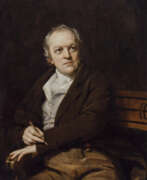

William Blake was an English poet, painter, and printmaker. Largely unrecognised during his life, Blake is now considered a seminal figure in the history of the poetry and visual art of the Romantic Age. What he called his "prophetic works" were said by 20th-century critic Northrop Frye to form "what is in proportion to its merits the least read body of poetry in the English language". His visual artistry led 21st-century critic Jonathan Jones to proclaim him "far and away the greatest artist Britain has ever produced". In 2002, Blake was placed at number 38 in the BBC's poll of the 100 Greatest Britons. While he lived in London his entire life, except for three years spent in Felpham, he produced a diverse and symbolically rich collection of works, which embraced the imagination as "the body of God" or "human existence itself".


François Boucher, a French artist, is celebrated for his significant contributions to the Rococo style of painting. His works are renowned for their idyllic and voluptuous themes, which include classical subjects, decorative allegories, and pastoral scenes. Boucher's talent in creating intricate and charming paintings made him a favorite in the French court, especially with Madame de Pompadour.
François Boucher's skills were not confined to painting alone; he was also an adept draftsman and tapestry designer. His designs for the Beauvais tapestry workshops were highly successful, influencing decorative arts across Europe. Moreover, Boucher's influence extended to porcelain, with his designs being replicated on tableware and decorative pieces at the Vincennes and Sèvres factories.
Despite the later criticism of his style as overly frivolous and disconnected from the emerging Neoclassical trends, François Boucher's works continue to be admired for their aesthetic beauty and historical significance. His ability to blend various elements into a cohesive and appealing visual narrative demonstrates his mastery and enduring legacy in the art world.
For art collectors and enthusiasts, François Boucher's oeuvre offers a fascinating glimpse into 18th-century French art and culture, reflecting the opulence and delicate tastes of the Rococo period. His paintings and designs continue to be celebrated and studied for their artistic merit and historical context.
To stay updated on the latest exhibitions, sales, and events related to François Boucher's works, consider subscribing to updates from reliable art and antique sources. This way, you'll remain informed about opportunities to engage with the art of one of Rococo's most distinguished masters.
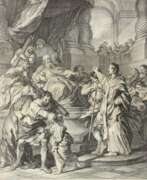

Charles-Nicolas Cochin the Elder was a French painter and line engraver.
Charles-Nicolas Cochin the Elder painted until the age of twenty-two, and then devoted himself entirely to engraving. In 1731 he became an academician, and on the occasion of his reception engraved portraits of Jacques Sarracen and Estache Le Sueur. He then turned his attention to the fanciful subjects of Watteau, Lancret, and Chardin, after which he executed several fine works.


Charles-Nicolas Cochin was a French engraver, designer, writer, and art critic. To distinguish him from his father of the same name, he is variously called Charles-Nicolas Cochin the Younger, Charles-Nicolas Cochin the son, or Charles-Nicolas Cochin II.
More than fifteen hundred works by Cochin can be identified. They include historical subjects, book illustrations, and portraits in pencil and crayon. The richest collection of his engravings, apparently selected by himself, is in the Royal Library, now part of the Bibliothèque nationale.


Richard Corbould was an English artist. He was a painter, in oil and watercolour, of portraits, landscape, and occasionally history; of porcelain, and miniatures on ivory, and enamels; and was furthermore an important illustrator of books renowned for his Napoleonic sketches of Ships, and a follower of the old masters. From 1777 to 1811 he was a constant contributor to the Royal Academy.


Romeyn de Hooghe was a Dutch painter, sculptor, engraver and caricaturist of the late Baroque period, writer and philosopher.
Hooghe became famous for his political caricatures of King Louis XIV of France and propaganda pamphlets in support of William of Orange. He portrayed the war against the French monarch and his allies as a struggle between freedom and religious despotism.
Romeyn de Hooghe was a superb engraver and created over 3,500 engravings during his lifetime. His most important work is Hieroglyphica of Merkbeelden der oude volkeren (Hieroglyphics or Symbols of the Ancient Peoples), where he appeared not only as a consummate master of engraving, but also as a historian, talented writer and philosopher. This book has long been regarded in Europe as one of the most authoritative sources on classical mythology. It contains 64 engravings illustrating all stages of the narrative of myths, ancient cults and beliefs, and the interpretation of scripture, a guide to medieval Europe.
Romeyn de Hooghe also illustrated books and painted large panels. During his lifetime he was widely recognized as a painter and sculptor not only in his own country but also in other European countries.


Philibert-Louis Debucourt was a French painter, caricaturist and engraver.
Debucourt was a specialist in color printing techniques and worked mainly with aquatint. He made engravings based on his own paintings as well as those of Charles Vernet, Louis-Leopold Boileau, and Nicolas-Toussaint Charlet.
Debucourt also competed in wit with British cartoonists who were active when revolutions were raging in Europe. Debucourt depicted people admiring each other in the gardens of the Palais Royale as Paris prepared for carnage. During the Napoleonic period, French political caricature was in its infancy, and Debucourt merely mocked French manners and morals by painting satirical portraits.
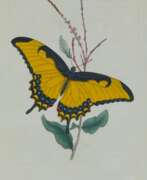

Edward Donovan was a British-Irish amateur zoologist, illustrator and writer.
He was an avid collector and founded the Natural History Museum and Institute in London, which housed his extensive collection of natural history objects. Donovan was the author of a large number of works on natural history, and wrote several volumes on British birds, fish, and insects, botanical surveys, and on the entomology of China and India. All of these publications were supplied with good quality and detailed illustrations.


Georg Dionysius Ehret was a German botanist and entomologist known for his botanical illustrations.
Ehret's original art work may be found at the Natural History Museum in London, the Royal Botanic Gardens, Kew, The Royal Society, London, the Lindley Library at the Royal Horticultural Society, the Victoria and Albert Museum, at the University Library of Erlangen, the LuEsther T. Mertz Library of the New York Botanical Garden, and the Hunt Institute for Botanical Documentation in Pittsburgh, Pennsylvania.


Franz Ertinger (German: Franz Ertinger) was a French painter born in Germany but working in France and Flanders, a member of the Guild of St. Luke in Antwerp.
Ertinger is a versatile artist who has applied his talents in various fields of art. He is known as a painter, illustrator and printer of books, draughtsman, designer and writer, and worked as a royal engraver in Paris.


John Flaxman was a British sculptor and draughtsman, and a leading figure in British and European Neoclassicism. Early in his career, he worked as a modeller for Josiah Wedgwood's pottery. He spent several years in Rome, where he produced his first book illustrations. He was a prolific maker of funerary monuments.


Christian Gottfried Heinrich Geißler was a German draughtsman, printmaker and illustrator.
After studying at the Leipzig Art Academy, Geißler went to St. Petersburg in 1790 and worked there as an art teacher. In 1793-1794 Geißler took part in an expedition to southern Russia organized by Catherine II, under the direction of Peter Simon Pallas, as a painter and engraver, during which he depicted various costumes of the local inhabitants. After his return to Leipzig in 1798, these documentary sketches formed the basis of illustrations for Pallas's travel notes and popular science books on the manners and customs of the Russian tribes, which he published with Johann Gottfried Gruber and Johann Gottfried Richter.
Geißler was also the author of the engravings of the famous album "Depiction of the uniforms of the Russian Imperial Army" (St. Petersburg, 1793). In Leipzig, Geißler illustrated children's books and also kept an illustrated chronicle of the French occupation between 1806 and 1813.


Richard Harraden was a British painter and printmaker and engraver.
In London, where he was born, Harraden worked as an artist until 1798, and then moved to Cambridge. He was best known for his topographical illustrations of his native city, such as Cantabrigia Depicta (1809). Harraden's Pictorial Views of Cambridge depicts the university and the city of Cambridge in six large views and a frontispiece, as well as twenty-four small views based on original drawings by Richard Harraden.
With his son, Harraden founded the publishing house R. Harraden and Sons, which specialized in topography and executed most of his designs in etching or aquatint.


William Hogarth was an English painter, engraver, pictorial satirist, social critic, editorial cartoonist and occasional writer on art. His work ranges from realistic portraiture to comic strip-like series of pictures called "modern moral subjects", and he is perhaps best known for his series A Harlot's Progress, A Rake's Progress and Marriage A-la-Mode. Knowledge of his work is so pervasive that satirical political illustrations in this style are often referred to as "Hogarthian".


Katsushika Hokusai (Jap. 葛飾 北斎) was a well-known Japanese ukiyo-e artist, illustrator, etcher of the Edo period. He worked under many pseudonyms. He is one of the most famous Japanese engravers in the West, master of the concluding period of Japanese woodblock prints.
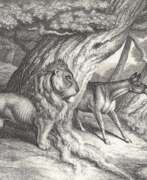

Samuel Howitt, full name William Samuel Howitt, was a British artist and illustrator.
Howitt was an amateur artist, but a very hardworking and talented one. For the most part, he painted hunting scenes, racing with horses, and depicted wild exotic animals in tropical landscapes. Howitt was also an engraver, creating many plates from his drawings, and a gifted illustrator, decorating several hunting and sporting books and fables with his drawings.


Adrien Jolly or Joly, real name Adrien Jean Baptiste Muffat, was a French painter, musician and theater actor.
After completing his army service, Jolly played at the Théâtre Molière in Paris from 1802, and as a painter he executed hundreds of illustrations on various subjects.


Johann Friedrich Jügel was a German painter, illustrator and printmaker.
Jügel mastered the technique of aquatint etching, which earned him fame among his contemporaries. He collaborated with many famous artists. The skillful master created portraits, topographical views and architectural structures, such as a large view of the Berlin Theater, as well as engravings with patriotic and military scenes and uniforms of the Civil Guard and the Prussian army. Famous, for example, is a beautiful album of the Royal Prussian Infantry with detailed illustrations of each corps' uniforms and insignia, the drawings for which were done by the artist Friedrich Lieder (1780-1859) and the aquatints engraved by Jügel.
From 1823, Jügel also taught copper engraving at the Prussian Academy of Arts.


Torii Kiyoshige I was a prominent Japanese artist, active during the Edo period. His works, primarily consisting of woodblock prints and paintings, reflect a significant era in Japanese art history. Kiyoshige's contributions are notable for their vivid depictions and artistic elegance, representing the rich culture and art of Japan during this period.
One of Kiyoshige’s renowned works is "The Second Sawamura Sojuro in the Role of Ume no Yoshibei," a woodblock print created in the second month of 1763. This piece is a fine example of his skill in capturing the essence of Kabuki theatre actors through the ukiyo-e art form. The artwork showcases his ability to blend colors and ink on paper, creating a lifelike representation of the actor's character. This piece is part of the collection at The Metropolitan Museum of Art.
Another significant work by Torii Kiyoshige I is "The Warrior Asahina Yoshihide Lifting a Puppet of a Courtesan on a Go Board." This mid-18th-century piece is a hanging scroll, demonstrating Kiyoshige’s versatility in different mediums. The artwork features ink, color, and gold on paper, presenting a unique and intricate composition. This piece, also housed in The Metropolitan Museum of Art, is part of the Mary Griggs Burke Collection, highlighting the importance of Kiyoshige's work in international art collections.
Torii Kiyoshige I’s artistry is not only a reflection of his individual talent but also an embodiment of the cultural and artistic vibrancy of Edo-period Japan. His works, residing in prestigious museums, continue to be a subject of admiration and study for collectors, auctioneers, and art experts worldwide.
For those interested in keeping up to date with sales and auction events related to Torii Kiyoshige I’s works, signing up for updates is highly recommended. This subscription offers a professional and focused way to stay informed about new opportunities to appreciate and acquire pieces related to this influential artist.


Joseph Anton Koch was an Austrian painter, draughtsman and printmaker, master of etching and illustration, novelist and representative of the classicist landscape in German art. In his native country he was associated with the Biedermeier aesthetic, and in Rome with the Nazarene society.


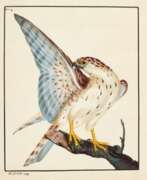

William Lewin was a British naturalist, ornithologist and illustrator.
Lewin for 20 years observed various birds and made sketches. And in 1789, with the help of his three sons, he began publishing a multi-volume work entitled "The Birds of Great Britain and their Eggs". It is truly a monumental work: 7 volumes, 323 hand-colored watercolor and gouache drawings of birds and their eggs. They were all painted by Levin himself for the first 60 subscribers to the publication. He did not complete the second edition, a more detailed one, and after his death his sons completed the publication.
This work is considered one of the rarest of all English bird books. Lewin's birds are depicted much more vividly and realistically than those of earlier artists, as he painted mainly from life rather than relying on specimens. Lewin also produced a volume on butterflies, where they are systematized and careful illustrations are drawn from life.
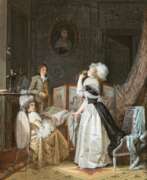

Jean-Baptiste Mallet was a French painter in the Troubadour style.
His style shows the strong influence of Jean-Baptiste Greuze, Jean-Honoré Fragonard (also from Grasse) and Louis Léopold Boilly. He is also known to have studied 17th-century Dutch painting.
Most of his works were gouaches and watercolors, done in relatively small formats, and consist largely of genre scenes depicting life under the Directorate and the First Empire.
His paintings were very popular and are an indispensable source of information about interior decorations and furnishings of the period. Most of his works were also available as prints.
Outside of France, his works may be seen at the National Gallery of Art and LACMA.


Maria Sibylla Merian was a German-born naturalist and artist renowned for her contributions to entomology and botanical art. Born in Frankfurt am Main in 1647, Merian gained recognition for her detailed studies and illustrations of insects and plants, focusing on their life cycles and metamorphosis, which significantly advanced the field of entomology.
Maria Sibylla Merian's journey into the world of natural history began in her hometown of Frankfurt, where she started studying insects, particularly their metamorphosis. Her marriage to Johann Andreas Graff, an artist's apprentice, eventually took her to Nuremberg, where she continued her work and published her findings. Despite personal challenges, including an unhappy marriage, Merian's dedication to her studies remained unwavering.
A pivotal moment in Merian's life was her association with the Labadist community, where she delved deeper into her studies. Her time with the Labadists in Friesland allowed her to study a variety of species, further enriching her scientific endeavors. Merian's relentless pursuit of knowledge eventually led her to Amsterdam, a hub of scientific inquiry and trade, where she was exposed to a vast array of specimens from across the globe.
Maria Sibylla Merian's most ambitious expedition was to Suriname in South America, where she studied and documented the region's diverse flora and fauna. Her observations and illustrations from this expedition were groundbreaking, providing valuable insights into the natural world. Merian's works, including her detailed engravings and illustrations, not only captivate with their beauty but also serve as valuable scientific records. Her legacy is preserved in institutions like the National Museum of Women in the Arts, which houses some of her remarkable engravings.
Maria Sibylla Merian's life and work exemplify the profound impact of combining art and science, leaving an indelible mark on both fields. Her dedication to observing and documenting the natural world continues to inspire scientists and artists alike.
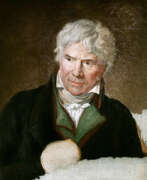

Jean-Michel Moreau, also known as Moreau le Jeune (the Younger), was a French artist, painter, illustrator and engraver.
He worked in the typical 18th-century Rococo style, creating paintings for later engraving, but most of his surviving work is book illustration. Moreau also created genre compositions on the entertainment of Louis XV and Madame Dubarry, later Louis XVI and Marie Antoinette. He painted portraits of members of the royal family from life in charcoal, chalk and pastel.
Jean-Michel Moreau created a large body of work on period costumes, accurately reproducing their details, which is a valuable source for today's costume designers and art historians.


Louis-Gabriel Moreau was a French graphic artist and landscape painter.
He is frequently identified as "Moreau the elder" ("Moreau l’Aîné") in order to avoid confusion with his precocious younger brother, the artist Jean-Michel Moreau (1741–1814) who is sometimes identified as "Moreau the younger" ("Moreau le Jeune").


Aleksander Orłowski (Russian: Александр Осипович Орловский), a renowned Polish painter and sketch artist, was born on March 9, 1777, in Warsaw, within the Polish-Lithuanian Commonwealth. His journey into the arts began under challenging circumstances; he was the son of a tavern-keeper and his family was not wealthy. His early promise in art was nurtured by noble patron Izabela Czartoryska, who financed his initial education under the guidance of artist Jan Piotr Norblin.
Orłowski's artistic journey intersected with his military service during the Kościuszko Uprising, a major revolt against Imperial Russia and Prussia in 1794. This period of conflict significantly influenced his later works, which often depicted military scenes and the daily life of soldiers. After the partitions of Poland, Orłowski moved to Saint Petersburg in 1802, where he became a seminal figure in the development of lithography in the Russian Empire.
His oeuvre includes a wide array of subjects, from battle scenes to cultural depictions of everyday life in both Poland and Russia. Notable works such as "Battle Scene" and "Cossack Fighting Off A Tiger" showcase his skill in capturing dynamic movement and drama. His works are preserved in esteemed institutions such as The Russian Museum and The Tretyakov Gallery, highlighting their historical and artistic value.
Orłowski's impact extended beyond the canvas; he was also mentioned in literary works by notable authors like Adam Mickiewicz and Alexander Pushkin, which underscores his cultural significance in the 19th century.
For collectors and experts in art and antiques, Aleksander Orłowski's works represent a crucial segment of Eastern European art history. To stay informed about new discoveries or auction events related to his works, consider subscribing for updates. This subscription ensures you receive timely information tailored to your interests, directly relating to new sales and significant events around Orłowski's art.


Jean-Baptiste Oudry was a French Rococo painter, engraver, and tapestry designer. He is particularly well known for his naturalistic pictures of animals and his hunt pieces depicting game. His son, Jacques-Charles Oudry, was also a painter.


Sydney Parkinson was a Scottish artist who sailed on the Endeavour with Captain Cook to South America, Tahiti, New Zealand and Australia.
The talented natural history illustrator was hired by renowned English naturalist and botanist Joseph Banks on James Cook's first voyage in the Pacific. In three years, Parkinson managed to make more than a thousand drawings of plants and animals collected by Banks and Daniel Solander during the voyage. And their number was staggeringly huge. He was also the first to draw the local inhabitants with the precision of an explorer. Parkinson's duties also included keeping a journal on board the ship. Without exaggeration, the artist's heroic and dedicated work under harsh conditions led to his premature death - he died of dysentery at sea on his way to Cape Town.
Sidney Parkinson was the first European artist to visit Australia, New Zealand and Tahiti. Without his Herculean efforts as a botanical artist, Banks' work would not have had such high scientific value. A large number of Parkinson's works have survived: the British Museum holds 18 volumes of his drawings of plants, of which eight relate to Australian plants, three volumes on zoological subjects, of which several sketches relate to Australia, and many of his landscapes and other drawings, mostly of the inhabitants of Tahiti and New Zealand.


Giuseppe Piattoli the Younger was an Italian painter and engraver, active mainly in Florence.
There are works by Servolini in the church of Santa Maria Maddalena dei Pazzi. He engraved a series of the Miracles of the miracles of the 16th-century Dominican mystic Bartolomea Bagnesi. He was appointed by Grand Duke of Tuscany, Peter Leopold to posts at the Real Galleria and the Accademia di Belle Arti of Florence.


Pierre-Joseph Redouté was a French artist and botanist of Belgian origin, a royal painter and lithographer.
Redouté traveled extensively from his youth and carefully studied the pictorial art of various masters, but his main interest eventually became botanical illustration. He gained access to the Botanical Gardens in Paris and the botanical library. Over time, the talented Redouté became a very popular and successful painter of flowers and plants, publishing more and more albums.
In the 1790s, Redouté was internationally recognized as one of the most popular floral artists in the world. His depictions of plants are still as fresh as if they had just been painted. His album of watercolor illustrations, The Lilies, is one of the most expensive printed books in history.
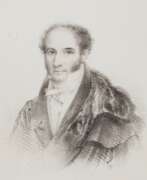

José Ribelles y Helip or Felip was a Spanish painter and draftsman.
He studied at the Royal Academy of Fine Arts of San Carlos, then continued his studies in Madrid. José Ribelles painted biblical subjects, portraits, and illustrated the 1819 edition of Don Quixote. He is the author of frescoes in the Royal Palace and the theaters of Caños del Peral and Principe.
José Ribelles also prepared more than a hundred drawings of Spanish costume from various regions of Spain, from which Juan Carrafa (1787-1869) then produced engravings. The engravings depict various professions, including bullfighters, gypsies, sailors, merchants, fishermen, students, porters, etc. The selection was published in Real Calcografía from 1825.


Christian Bernhard Rode was a German painter of the second half of the eighteenth century. He is known as a historical painter and printmaker, closely associated with the Berlin Enlightenment movement.
Bernhard Rode became famous for his works depicting historical events and allegorical works. His works combined a variety of techniques, including paintings, engravings, book illustrations, and reliefs. He embodied motifs from the Old Testament, ancient mythology, history, and literature contemporary to him.
Rode was director of the Berlin Academy of Fine Arts from 1783 to 1797.


Thomas Rowlandson was an English artist and caricaturist of the Georgian Era, noted for his political satire and social observation. A prolific artist and printmaker, Rowlandson produced both individual social and political satires, as well as a large number of illustrations for novels, humorous books, and topographical works. Like other caricaturists of his age such as James Gillray, his caricatures are often robust or bawdy. Rowlandson also produced highly explicit erotica for a private clientele; this was never published publicly at the time and is now only found in a small number of collections. His caricatures included those of people in power such as the Duchess of Devonshire, William Pitt the Younger and Napoleon Bonaparte.


Paul Sandby was a British watercolorist, draughtsman and printmaker, and a founder member of the Royal Academy.
Sandby first worked as a draughtsman and cartographer before painting his first paintings, watercolors of bridges, fortifications and Scottish landscapes, as well as views of Windsor. These works eventually made him a sought-after artist. Sandby also painted many caricatures and skillfully documented eighteenth-century British social life.
In 1768, Sandby, his brother Thomas Sandby and 27 other artists became founding members of the Royal Academy in London. He is now considered one of the founders of English watercolor.


Jean Gabriel Scheffer was a Swiss-born painter and lithographer based in Paris.
Scheffer painted portraits as well, but became better known as a genre painter and lithographer. By the early 1820s, Scheffer had firmly established himself on the Parisian art scene, and from 1822 his work was exhibited at the Paris Salon. He collaborated with the printer-publisher Chez Martinet, creating the popular albums Scenes of Young People (1825), What They Say and What They Think (1829), and Little Travelers (1830).
Scheffer's illustrations, with charm and in his characteristic wryly humorous style, offered a unique perspective on typical scenes and were eagerly purchased by the general public. Jean Gabriel Scheffer captured the modern mores, customs, and costumes of Parisian society in his works.
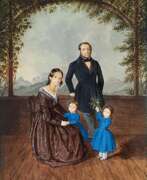

Johannes Heinrich Senn was a Swiss painter and illustrator.
Johannes Senn was born into the family of painter Jacob Senn, studied art in Switzerland, and in 1808 traveled to Copenhagen, Denmark. He lived and worked there until 1818, which is why he is often referred to as the Scandinavian painter.
Zenn worked primarily in portrait painting. Among his best known portraits is a watercolor of the family of King Frederick VI of Denmark, showing the king himself, his wife Queen Mary, and their two daughters on a walk in the park. Zenn also illustrated several series of works depicting the clothing of residents throughout Denmark and Norway.


Jan Christiaan Sepp was a Dutch book publisher, printmaker and illustrator.
Jan Christiaan Sepp belonged to a dynasty of collectors, publishers and traders in printed books founded by his father, Christian Sepp (c. 1700-1775) in Goslar, Germany. Jan Christian Sepp is known for being the chief illustrator, creating the magnificent engravings for Cornelius Nozeman's highly prized work entitled Nederlandsche Vogelen (Birds of the Netherlands, 1770-1829). These copperplate engravings, superbly composed, meticulously engraved and hand-colored are of great value.
After Christian Sepp's death, the work of illustrating the five volumes was completed by his son, Jan Sepp. Each volume of this five-volume work of science and art contains 50 images of bird species, and each species is described on several pages.


Frederic Shoberl or Frederick Schoberl was a British journalist, editor, translator, writer and illustrator.
Along with publisher Henry Colburn, Schoberl was the creator and co-owner of the New Monthly Magazine, which began publication on February 1, 1814. He acted as editor for a time, publishing original articles and reviews. Frederick Schoberl worked closely with publisher Rudolf Ackerman (1764-1834) for a long time, editing his Vault of Art from March 1809 to December 1828. He also kept Ackerman's English yearbook, Nezabudka, from 1822 to 1834, and worked on many other publications.
In addition to his editorial work, Frederick Schoberl produced excellent illustrations, for example for the book The World in Miniature: Hindustan, which was published in London by Ackerman in the 1820s.


James Sillett was a British painter and botanical illustrator.
Sillett was a versatile artist of the Norwich school: he produced landscapes with accurate sketches of architectural structures, portraits, and was also a master of botanical still lifes. His paintings often have an academic style, and his illustrations for botanical publications were praised for their accuracy and attention to detail. He also did illustrations of various animals in natural history.


Charles Hamilton Smith was a British illustrator, naturalist, writer, and military spy.
In connection with his military service, Smith traveled extensively throughout the United States, Canada, and India. He was also a talented self-taught artist and illustrated historical works on the military uniforms of the British Empire army, medieval life, drew costumes of native and ancient inhabitants of the British Isles, costumes for the theater stage, and sketched various animals. In 1848 Smith published The Natural History of the Human Species.


Christian Gottlieb Steinlen, also known as Théophile Steinlein, was a Swiss painter, watercolorist, illustrator and engraver.
Steinlein created many views of Vevey's surroundings and taught at the Vevey College of Fine Arts. He was responsible for the design of the official album for Vevey's grand celebration, the 1833 Winegrowers' Festival, and was also the designer of the participants' costumes and decorations. The official booklet he created included several wood-engraved illustrations as well as two sets of thirty engraved plates.
The artist Theophile Alexander Steinlen (1859-1923) was the grandson of Christian Gottlieb Steinlen.


Cornelius Suhr was a German painter, lithographer and publisher.
Cornelius is a member of the Suhr family of painters from Hamburg, the younger brother of Christoffer Suhr (1771-1842) and the older brother of Peter Suhr (1788-1857).
After 1805, he and his older brother Christoffer began painting panoramic views of their hometown in gouache, creating landscape paintings from all over Hamburg. Cornelius was also responsible for their distribution. Later, Peter Suhr joined the family business, forming a general lithographic company that also printed books and playing cards. Together they produced several hundred lithographs, engravings and etchings.


Jean-Joseph Taillasson is a French painter, illustrator and art historian. He studied painting in the studio of Joseph-Marie Vien. In 1769, he won the Third Prix de Rome. He lived in Italy from 1773 to 1777, and upon his return to Paris set an early example of neoclassicism.
Jean-Joseph Thaisson, as a member of the Royal Academy of Painting and Sculpture, was housed in the Louvre. After the revolution, he was fortunate enough to settle at the "Musée des Artistes" in the Sorbonne.


Ivan Philippovich Tupylev (Russian: Иван Филиппович Тупылев) was a Russian artist of the last quarter of the 18th - first quarter of the 19th centuries. He is known as a painter and graphic artist, a master of historical and portrait genres.
Ivan Tupylev painted historical paintings, portraits of royalty and other nobles, as well as icons for churches. As a graphic artist, he illustrated the "Metamorphoses" by the ancient Roman poet Ovid and a book devoted to Palladianism - the architecture of early classicism - published in Russia.


Thomas Uwins was a British painter and illustrator, and a Royal Academician.
Uwins was a versatile artist, painting portraits, genre scenes, landscapes in watercolor and oil, and book illustrations. Uwins taught, was a member of the Society of Old Watercolorists, and held a number of high-ranking artistic positions, including librarian of the Royal Academy, inspector of Queen Victoria's paintings, and curator of the National Gallery.


John Vanderbank was a British portrait painter and book illustrator.
Vanderbank was one of England's most famous portrait painters of the 1720s and 1730s, and is the author of portraits of many prominent figures in Britain, including the royal family. His portrait of Isaac Newton (1725) is now in Trinity College, Cambridge. Vanderbank was also a gifted draftsman, notably illustrating the 4-volume edition of Don Quixote.
Vanderbank was a very influential and successful artist of his time, with contemporaries prophesying a great destiny for him. However, his unrestrained lifestyle led to constant financial difficulties and an early death at the age of only 45.


Johannes Eusebius Voet was a Dutch physician, poet, entomologist and illustrator.
Voet worked as a physician in Dordrecht and had a large collection of insects and shells. Studying beetles and other insects, he wrote Catalogus Systematicus Coleopterorum, Systematische naamlijst van dat geslacht der Insecten dat men Torren noemt, which was published in 1804-1806. It was one of the best entomological works published in the Netherlands. It contained numerous original hand-colored engravings, many of them by C.F.C. Kleemann, Rösel's son-in-law.


Johann Peter von Langer was a German painter of the last quarter of the eighteenth and first quarter of the nineteenth centuries. He is known as an academic painter, draughtsman and printmaker, as well as a teacher.
Von Langer painted religious and historical paintings and portraits, as well as graphic illustrations. Many of his drawings and engravings are preserved in the State Graphic Collection in Munich. Langer was the director of the Academy of Fine Arts in Munich. In 1808 he received the title of Bavarian nobility. The master's contribution to art was also recognized in the Netherlands, where he was accepted as a member of the Royal Academy.


Francis Wheatley was a British painter and illustrator, a Fellow of the Royal Academy of Arts.
He successfully studied at the Royal Academy of Arts, but was soon forced to flee to Ireland, where he established himself as a portrait painter and created one of his most famous works, "The Irish House of Commons". Wheatley also painted genre scenes from rural life, landscapes. Later, back in England, Wheatley collaborated with print publisher John Boydell and created works for the Shakespeare Gallery that were later engraved, and it was his illustrations of novels and various genre subjects that formed Wheatley's enduring reputation as a talented illustrator.
In 1791 Wheatley was elected a full member (Academician) of the Royal Academy of Arts.
Today, Francis Wheatley is best known for his two portraits of Admiral Arthur Phillip, the founder of the permanent British settlements in Australia, which today always illustrate the history of the exploration of the Australian continent.


James Brydges Willyams was a British artist, draughtsman and satirical writer.
Lt. Colonel Williams is known for his moralizing work A Compendious Treatise on Modern Education, in which he mocks the ills of modern society, from child hoodlums and teenage drunks, careless nannies to university students and professors. Williams signed his texts and drawings with the pseudonym Joel McCringer. And the artist Thomas Rowlandson (1756-1827), who printed the engravings from Williams's drawings, infused the figures with his characteristic elegance.


Alexander Wilson was a Scottish-born American naturalist, ornithologist, illustrator, and poet.
Wilson emigrated from Scotland to America in 1794, spent several years teaching in Philadelphia and New Jersey, and then became interested in studying native birds. He traveled extensively in the American wilderness and captured and studied over 300 different birds, including several previously unknown. He made his own drawings and detailed descriptions, supported by reading scientific literature.
The results of his research were published under the title American Ornithology in eight volumes beginning in 1808. The ninth volume was published after his death in August 1813. One of the first subscribers was President Thomas Jefferson. Alexander Wilson was a member of the Society of Artists of the United States and the American Philosophical Society. The Wilson Ornithological Society is named in his honor, and a monument is erected in Abbey Close, Paisley. Several species of birds are named in his honor.


George Murgatroyd Woodward, nicknamed Mustard George, was a British cartoonist and satirical writer.
His caricatures were printed in humor magazines and published as prints. Woodward mocked both newfangled trends, human vices, including drunkenness, and politicians, as well as illustrating and decorating books.


John Young was a British engraver, illustrator and publisher, and a curator of the British Institution.
Young worked exclusively in mezzotint and was a master of this technique; he executed some eighty portraits of contemporary characters from paintings by famous artists. In 1789 he was appointed mezzotint engraver to the Prince of Wales.
In 1815. Young published an album, Portraits of the Emperors of Turkey from the Founding of the Monarchy to 1808, consisting of thirty color plates with text in English and French. It is interesting that this series of portraits of Turkish emperors based on the album of miniatures of the XIX century was commissioned by the 28th Sultan Selim III, who ruled from 1789 to 1807, and after his death under Sultan Mahmud II the work was continued, which testifies to the high interest of the Ottoman Empire in European art.


Benjamin Zix was a French painter, engraver, and illustrator.
He is known for accompanying Napoleon's military campaign, producing many battlefield drawings. Zix also painted portraits, mythological scenes, allegories, landscapes, and caricatures.




